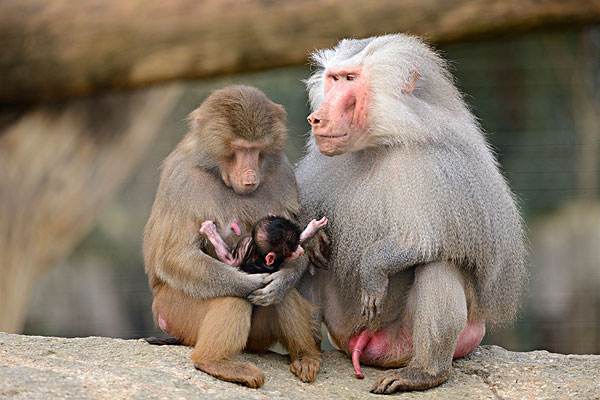Papio hamadryas
IUCN
LCBasic Information
Scientific classification
- name:Papio hamadryas
- Scientific Name:Hamadryas baboon, Egyptian baboon, dog-headed monkey
- Outline:Primates
- Family:Primates Cercopithecidae Papio
Vital signs
- length:61-75 cm (males are larger)
- Weight:9.2 - 21.5 kg
- lifetime:30 Year
Feature
It is the smallest species of baboon and a famous "kidnapper" in the monkey world.
Distribution and Habitat
Distributed in Djibouti, Eritrea, Ethiopia, Saudi Arabia, Somalia, Sudan, Yemen. Regionally extinct: Egypt. Inhabits sparse tropical steppes and rocky slopes with few trees in semi-desert areas.
Appearance
The Arboreus baboon is the smallest of the baboons. It has an ugly face and strange colors. The male is 70-75 cm long, with a tail length of about 25 cm and a weight of 18-20 kg. The female is much smaller than the male. It has a large head, high protruding brow bones, dark and deep eyes, a long and angular snout, a high ridge on the face, and a bright blue and purple color. The nose is deep red, and the bridge of the nose reaches the forehead, which is slightly like a dog's head, so it is also called a dog-headed monkey.
The female's snout is slightly shorter, the face is flesh-colored, smooth and hairless. The limbs are very strong, the hands and feet are black, suitable for walking on the ground. The tail is slender, and there is a large patch of bright red on the buttocks. The body hair is rough, the male is gray-brown, and the female is brown-green.
The male has long and prominent canine teeth on the upper jaw, and long hair is scattered from both sides of the head
Details
If the monkey world were to hold a "beauty pageant", the Arabian baboon would never lack confidence, with its heart-shaped red buttocks and silver-white brushed "trendy" hair, it would have a natural and suave style.

As the main object of wildlife biologists' research on primates for a long time, not only because of the group phenomena similar to human society, but also some individual phenomena similar to human society. There are always some people in human society who are not enterprising and want to satisfy their consumption needs by stealing other people's property, so the thief business appears. There are also such characters in the Arabian baboon group. They don't steal anything else, but only steal newborn monkey babies, so they are also famous "kidnappers" in the monkey world.
Like humans, Arabian baboons need to drink water every day, so they spend a certain amount of time looking for water sources every day and then stay near the water source for a while. If a lion sees a group of baboons drinking water by the water, it will then ambush by the water and wait for the arrival of the baboon group. Little do they know that the mantis stalks the cicada, and the oriole is behind. Arabian baboons even plan to drink water carefully. A group preparing to drink water is usually led by the strongest male individual, with a few "little brothers" behind him.
Then the other individuals climbed up the trees around the water source. If the lion ambushed near the water source launched an attack at this time, the leading male individual would bravely confront the lion head-on, and the other individuals hiding in the tree would collectively roar, and then pick the fruits on the tree and throw them at the lion. The few "little brothers" following the leading baboon were even more ruthless, and directly picked up stones on the ground and threw them at the lion. When a lion faces a collective attack by a group of baboons, it often cannot withstand the counterattack and flees.
In the habitats of Arabian baboons, lions are usually their natural enemies. Although group combat can repel lions, there will always be times when individuals are left alone. Therefore, in order to protect family members and prevent lions from attacking at night, Arabian baboons climb high trees to scout the surrounding environment before going to bed every night. They will not sleep peacefully until they are sure there are no natural enemies.
They were once hunted and traded for their fur and medical research, and artificial transformation of natural habitats such as fields and pastures is one of the main threats to Arabian baboons. The number has increased and is listed as Least Concern.
Listed in the 2008 Red List of Endangered Species of the World Conservation Union (IUCN) ver 3.1 - Least Concern (LC).








